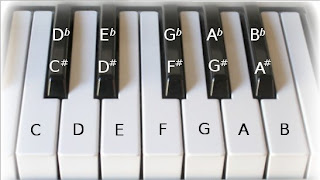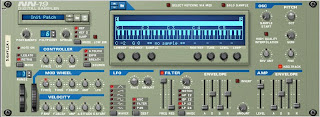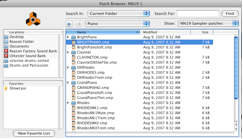1.Getting familiar with how a keyboard looks.
2.Learning the names of the white keys of the keyboard
3.Recording ourselves playing the C Major scale
Keys of the Keyboard
OK, keyboards can look kind of confusing, but they are actually pretty simple once you know how they’re made up. First of all there are two main types of keys: white keys and black keys.
Here is what they all look like:

As you can see, there are 12 different keys in all.
You may be thinking, "But I've seen a piano before and I know they've got a lot more keys than that." That’s sort of true…
Take a look at this picture of a full sized piano keyboard:
 Do you notice any patterns? Pay special attention to the black keys for a second – see how it’s just groups of 2 and 3 keys switching off. Can you see how the pattern just repeats itself over and over?
Do you notice any patterns? Pay special attention to the black keys for a second – see how it’s just groups of 2 and 3 keys switching off. Can you see how the pattern just repeats itself over and over?Basically, the whole keyboard is just made up of the same 12 keys repeating. A set of these 12 keys is called an octave. As you go to the right, the pitch gets higher, as you go to the left, the pitch gets lower, but there are always just the same 12 keys.
(Instructor: Demonstrate by playing a specific note –e.g C - at different octaves.)
"What are the names of these notes?" you ask. Super easy...
The white keys are just the first 7 letters of the alphabet (A-B-C-D-E-F-G)
The black keys are the same letters, only with extra things called sharps and flats.
We'll talk more about the black keys later. For now let’s just concentrate on the white keys:

In the picture above, what is the name of the first key on the left? What happens when you go up 12 keys to the right? If we could see more of the keyboard, what do you think the next white note to the right would be?
The big thing to remember for today…
The white keys are just the first 7 letters of the alphabet (A-B-C-D-E-F-G)
If you play each of these white keys in order, from C to C, you are playing what is called the C Major scale.
(Instructor: Demonstrate playing C Major)
Here is a video of a guy playing C Major with his right hand. Pay close attention to the fingers he is using.
If you are left-handed, play like this:
Right now you are going to record yourself playing C Major with the keyboard.
Please do the following:
1.Get a keyboard and USB cable and plug it into your computer.
2.Start a new Reason file
3.Set the Tempo to 80 BPM
 4.Create an NN19 Digital Sampler (Create>NN19 Digital Sampler)
4.Create an NN19 Digital Sampler (Create>NN19 Digital Sampler)
5.Click on the Browse Patch button
 in the upper left corner of the NN19.
in the upper left corner of the NN19.6.Now let’s load a patch called “Bright Piano”…Go to Reason Factory Sound Bank>NN19 Patches.Pianos and Keyboards>Bright Piano.smp

7.Play a few notes on the keyboard. You should hear the sound of a piano. If you don’t, raise your hand and an instructor will help you.
8.In the Sequencer, put the L on Bar 1 and R on Bar 5. (You may need to zoom in to see the right numbers.)

9.Make sure that both the Click and Loop buttons are lit.


10.Hit Play and listen to the tempo of the click.
11.Practice playing the C Major scale up and down in time with the click – each note should be played on a click. Play the high C twice. If you need to, feel free to slow the tempo down.
12.When you are ready, hit Record and record yourself playing the scale up and back.
Hint – instead of trying to hit record and play right on the first click, wait for the playhead to play through once and then start playing when it loops back to the beginning.
13.Hit Stop when you are finished. If you don’t like your performance, delete it and try again. Keep trying until you get it right!
14.Save this as: your name_CMajorScale
15.Raise your hand and have the instructor come check your work.
Additional resources:
www.looknohands.com
Piano Scale Fingering
http://www.free-online-piano-lessons.com/piano-scales-practice-techniques.html
No comments:
Post a Comment